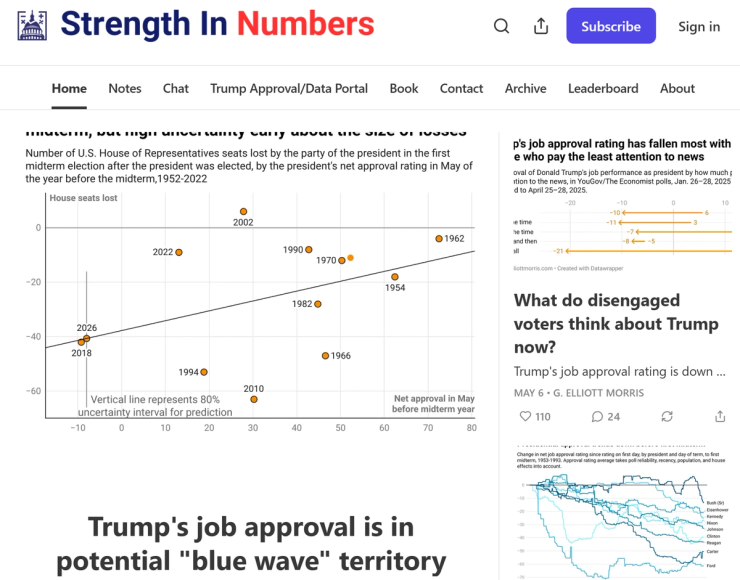The Scoop
The former head of 538, shuttered last year by ABC News, is building a new media outlet aimed at recapturing the defunct polling news site’s audience and building the kind of serious data journalism that has been abandoned by most legacy news organizations.
On Monday, G. Elliott Morris, the data journalist who took over 538 in 2023, is launching Strength In Numbers, a paid Substack that he plans on growing into a publication to rival his old website. The site, which has been operating for free for the past several months while Morris’ agreement with ABC runs out, will have daily items about national politics grounded in data without punditry.
In an interview with Semafor, Morris said that he was excited about the opportunity to build a new digital media organization from the ground up. But he said that part of the offering is aimed at correcting what he sees as the failures of legacy broadcast journalism in the 2020s, both in its business model and in what he said was its inability to speak honestly about threats to democracy.
“The moment we’re in in journalism and democracy right now is a lot harder to talk about if your news outlet is sort of expressly devoted to not pissing people off,” he said.
He added: “We’re going to be really nerdy about the news and talk to you like people, not treat you like idiots, and not try to obscure the story.”
Know More
After ABC decided in 2023 to cut costs at 538, resulting in layoffs and the departure of founder Nate Silver, it shocked the political journalism community with a surprising and somewhat bold move: hiring Morris, his upstart rival, to be 538’s editorial director of data analytics. The then-26-year-old pollster and analyst cast the moment as an opportunity to rebuild the site.
But by mid-way through 2024, Morris and 538’s relationship with ABC had deteriorated significantly. His election forecast model was more heavily weighted in favor of historical fundamentals like incumbency, and was suspicious of early state public opinion surveys — impulses that had served Morris and his team when accurately predicting the outcome of congressional elections at The Economist in 2018 and the presidential race in 2020 (he was slightly less successful in 2022).
But after Joe Biden’s disastrous position in a June debate, his emphasis on the non-polling elements distinguished him from his competitors in a way that was unpleasant for skittish ABC higher-ups. The network became uncomfortable that its analytic model was an outlier among the polls and poll aggregators in showing Biden still with a 50% chance of winning the election after the debate.
Biden’s departure from the race allowed 538 to reset its election forecast model. But the network was done with the unwanted attention. Semafor reported in August that 538 had adjusted its model following Biden’s decision to leave the 2024 race, but that rollout was delayed amid internal disagreement within ABC over whether and how much to explain the methodological revisions. ABC’s communications team also prohibited the staff from discussing or disclosing many details about the changes publicly, and the company’s lawyer strongly suggested changes to its methodology posts. Ultimately, 538 said the race was a coin toss, but correctly predicted that Republicans were likely to hold onto the Senate.
The ordeal frustrated staff at 538 and Morris, who had been open on X about his methodologies, and who felt that ABC had handicapped the team’s ability to do its job well and communicate with an audience desperate to understand the flood of political information.
“To the extent ABC has a PR strategy, it’s to deny and obfuscate, and hope that reputational hits heal magically by virtue of passing time. That strategy was constantly in conflict with ours, which focused on earning trust through transparency and personal author-audience relationships,” he said. “There is no reckoning internally with the brand’s loss of credibility over the last 20 years.”
Morris feels that the new independence will allow him to run a more nimble but expansive organization. He told Semafor that Strength In Numbers will also start doing some of its own surveys, and is launching a monthly online poll with a partner on Tuesday. Morris told Semafor that he has 16,000 free subscribers after just a few weeks on Substack, and hopes to generate enough revenue from paid subscriptions to scale up and hire more staff within the next several months (he expects that 6% of them will convert to paid subscribers, in line but slightly above what Substack told him it sees for publications on average).
“There’s enough interest that with just a little bit of monetization, know-how and content, you can make enough for it to be sustainable, at least at the beginning, from a small group of people,” he said. “And maybe, if you scale it up, even a lot of people.”


